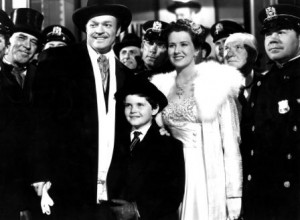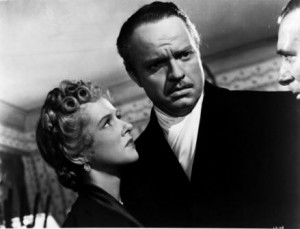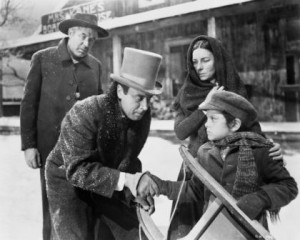Big names in film scoring, like those of cinematographers, were in their heyday at this time, and Scoring of a Dramatic Picture, only one of three music categories, had the ridiculous total of twenty nominations. Not just any nominations, the composers included Franz Waxman, Miklós Rózsa, Alfred Newman, Victor Young and that perennial nominee Max Steiner, some of them for two pictures. There were other lesser luminaries—Edward Ward, Louis Gruenberg, Ernst Toch and Frank Skinner. Erich Wolfgang Korngold’s absence from the first group was perhaps because his film that year, The Sea Wolf, was supposedly too dark and sparsely scored to deserve a nomination.
 But the Oscar went to none of these. Bernard Herrmann made his Hollywood début that year with two films, no less—Citizen Kane and All That Money Can Buy (The Devil and Daniel Webster). The latter, the more conventional of the two, won—not as dark and subtle as Kane, which, after all, was that “tainted” movie.
But the Oscar went to none of these. Bernard Herrmann made his Hollywood début that year with two films, no less—Citizen Kane and All That Money Can Buy (The Devil and Daniel Webster). The latter, the more conventional of the two, won—not as dark and subtle as Kane, which, after all, was that “tainted” movie.
On the heels of the notorious scare of his War of the Worlds radio broadcast, from which he deftly extricated himself of responsibility with feigned innocence and blatant lies, Welles was offered a control-over-everything contract to make a movie of his choice. From stage and radio he brought with him his favorite actors, who made their film débuts in Kane, including Joseph Cotton, Agnes Moorehead, Everett Sloane, Ruth Warwick, Ray Collins, George Coulouris and Paul Stewart. Some would become big stars, none more so than Cotton.
Citizen Kane is a cinematic milestone—one of a kind, and remains so to this date; it has dated not in the least, and as movie critic Pauline Kael wrote, “Citizen Kane is perhaps the one American talking picture that seems as fresh now as the day it opened. It may seem even fresher.” And Martin Scorsese remarked that the film and Orson Welles are “responsible for inspiring more people to be film directors than [anything] else in the history of cinema.”
 The movie is, indeed, a director’s film, with, at every shot, a tour de force demonstration of technique, almost to the point of being a distraction. There are the invisible wipes, optical illusions, deep focus photography, long takes and stationary cameras, seamless cuts, askew angles and low cameras that show actual ceilings, multiple dissolves, film noir darkness and shadows, moving furniture and a sophisticated use of the optical printer. Inexplicably ignored for a Special Effects nomination, the film has more special effects, as Ebert comments, than Star Wars.
The movie is, indeed, a director’s film, with, at every shot, a tour de force demonstration of technique, almost to the point of being a distraction. There are the invisible wipes, optical illusions, deep focus photography, long takes and stationary cameras, seamless cuts, askew angles and low cameras that show actual ceilings, multiple dissolves, film noir darkness and shadows, moving furniture and a sophisticated use of the optical printer. Inexplicably ignored for a Special Effects nomination, the film has more special effects, as Ebert comments, than Star Wars.
The plot of Citizen Kane is simple enough: super rich and super famous Charles Foster Kane has died, and after a news reel summary of his life of power and greed, reporter Jerry Thompson (William Alland) ventures to discover the real man beneath the fame—and to learn the meaning of his dying word, “rosebud.” Throughout the film, the reporter interviews those who knew the man—the wife, the mistress, the friends, the business associates.
Jedediah Leland (Cotton), the drama critic on Kane’s New York Daily Inquirer, sums up his boss: “That’s all he ever wanted out of life . . . was love. That’s the tragedy of Charles Foster Kane. You see, he just didn’t have any to give.”
Perhaps the most memorable interview, with Mr. Bernstein (Sloane), had nothing to do with Kane but was about a girl on a ferry. “A white dress she had on,” he remembers. “She was carrying a white parasol. I only saw her for one second. She didn’t see me at all, but I’ll bet a month hasn’t gone by since that I haven’t thought of that girl.”
In seeking the enigma of Kane, that reporter Thompson possibly came as close as anybody: “Maybe ‘rosebud’ was something he couldn’t get, or something he lost. Anyway, it wouldn’t have explained anything . . . I don’t think any word can explain a man’s life.” Or can it? Maybe.
 In the end of the movie, in an enormous warehouse containing the dead man’s hoarded stash, a wrecking crew consigns to the flames of a furnace Kane’s little sled that he had ridden in the winter scenes of his youth.
In the end of the movie, in an enormous warehouse containing the dead man’s hoarded stash, a wrecking crew consigns to the flames of a furnace Kane’s little sled that he had ridden in the winter scenes of his youth.
On the sled is inscribed “ROSEBUD.” Make of that what you will.
The new release is breathtaking and the film looks simply spectacular. The visual image is crystal clear but still has the look of film- without the flat perfection which mars some restored pictures- victims of over processing. The original soundtrack is preserved which is very robust, but of course doesn’t compare to more recent releases.
Overall, a must have release.
0 thoughts to “Citizen Kane (1941) with Orson Welles”